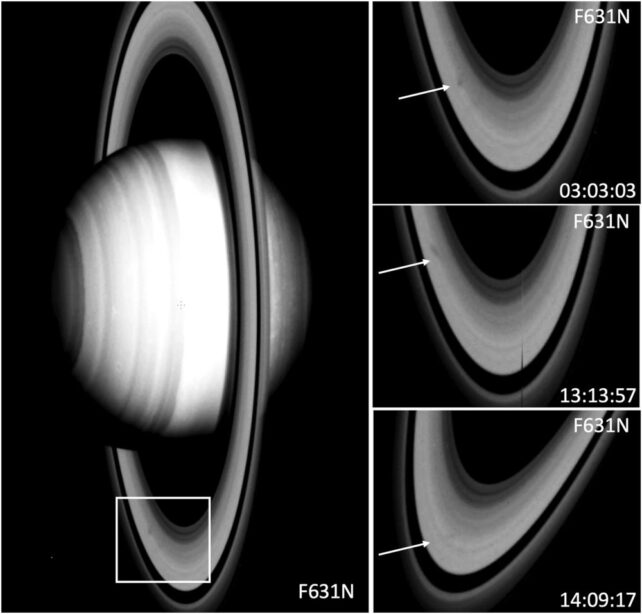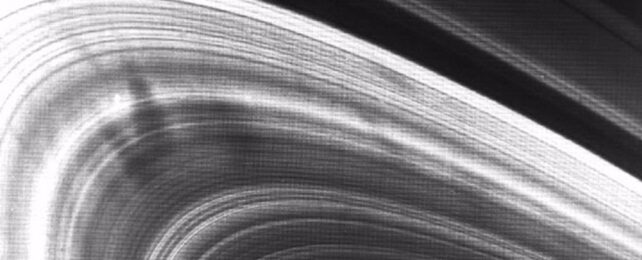The Hubble Space Telescope has confirmed that a new "spoke season" is kicking off at Saturn.
These are the times of the Saturnian year, centered around the equinoxes, when mysterious radial smudge marks, like the spokes of a wheel, appear across the planet's rings.
What exactly causes the spokes is unknown, but their re-emergence, combined with a Hubble planetary observing program, will provide opportunities to study them in greater detail.
Scientists hope to get to the bottom of not just what the spokes are but why they only emerge seasonally, disappearing and reappearing at certain times in Saturn's year.
"Thanks to Hubble's OPAL program, which is building an archive of data on the outer solar system planets, we will have longer dedicated time to study Saturn's spokes this season than ever before," says planetary scientist Amy Simon of NASA.
We first discovered Saturn's spokes in images from the two Voyager probes, which flew past Saturn in 1980 and 1981, respectively: temporary streaks and smudges that usually appear as radial features, moving with the rings as they orbit Saturn.
Further observation and analysis revealed more oddities. The spokes usually appear dark from above, while from below, they typically appear bright, and they're not always there.
Typically, the spokes appear only in Saturn's spring and autumn, for the eight-year period centered around the equinox, and disappear during summer and winter, for the period centered around the solstice.
Saturn is very different from Earth in many ways, but in one way, the two planets are alike. Both have a significant axial tilt with respect to their orbital plane; for Earth, that tilt is 23.45 degrees, and for Saturn, it's 26.73 degrees.
This tilt is what gives Earth its seasons. As our planet orbits the Sun, the Northern and Southern hemispheres receive more or less sunlight, depending on whether they are tilted towards or away from the Sun.
The point at which the tilt is the deepest is the solstice, occurring in summer and winter. The time of lowest tilt with respect to the Sun is known as the equinox, occurring in spring and autumn. Saturn has this too, but it also has rings, and they tilt, too. Saturn's rings tilt towards the Sun at the solstices, and at the equinoxes, the rings are pretty much edge-on.
Because Saturn is so much farther from the Sun, its year is longer, too. It takes 29 years for Saturn to orbit the Sun, and each of its seasons is around 7 years.
Decades of observations show that the spokes typically start to appear around four years before the equinox. The next equinox on Saturn is due to take place in 2025, so the start of "spoke season" was estimated to occur sometime in 2021.
"Despite years of excellent observations by the Cassini mission, the precise beginning and duration of the spoke season is still unpredictable, rather like predicting the first storm during hurricane season," Simon explains.
Hubble has been undertaking an observing campaign of the outer Solar System planets, the Outer Planet Atmospheres Legacy (OPAL) program, so Simon and her team tapped into that data to look for signs of the spokes in Hubble observations from 2021 and 2022. And right on schedule, the spokes appeared in 2021.

Then, in data from September 2022, the team tracked spokes over an 11-hour period. The spoke season is well and truly underway.
As for what causes them, scientists have some ideas. Data from several missions, including Voyager, suggest that the spokes themselves consist of dust particles from the rings separating from the icy chunks in the rings and levitating separately. And it could be Saturn's magnetic field that causes them to do so.
As the solar wind interacts with Saturn's magnetic field, it creates an electrically charged environment, a bit like a giant Van de Graaff generator. This could influence charged dust particles in Saturn's rings, causing them to electrostatically stick together, temporarily forming denser dust patches in the rings.
But it's not entirely clear if this is indeed what is occurring or why it is a seasonal phenomenon. Hubble data over the next few years could help scientists unravel the mystery.
"The Hubble OPAL program will continue its annual Saturn observational cadence for as long as the facility is operational," the researchers write, "and the spokes should soon be readily visible to ground-based telescopes, as well."
Their findings have been published in Geophysical Research Letters.
